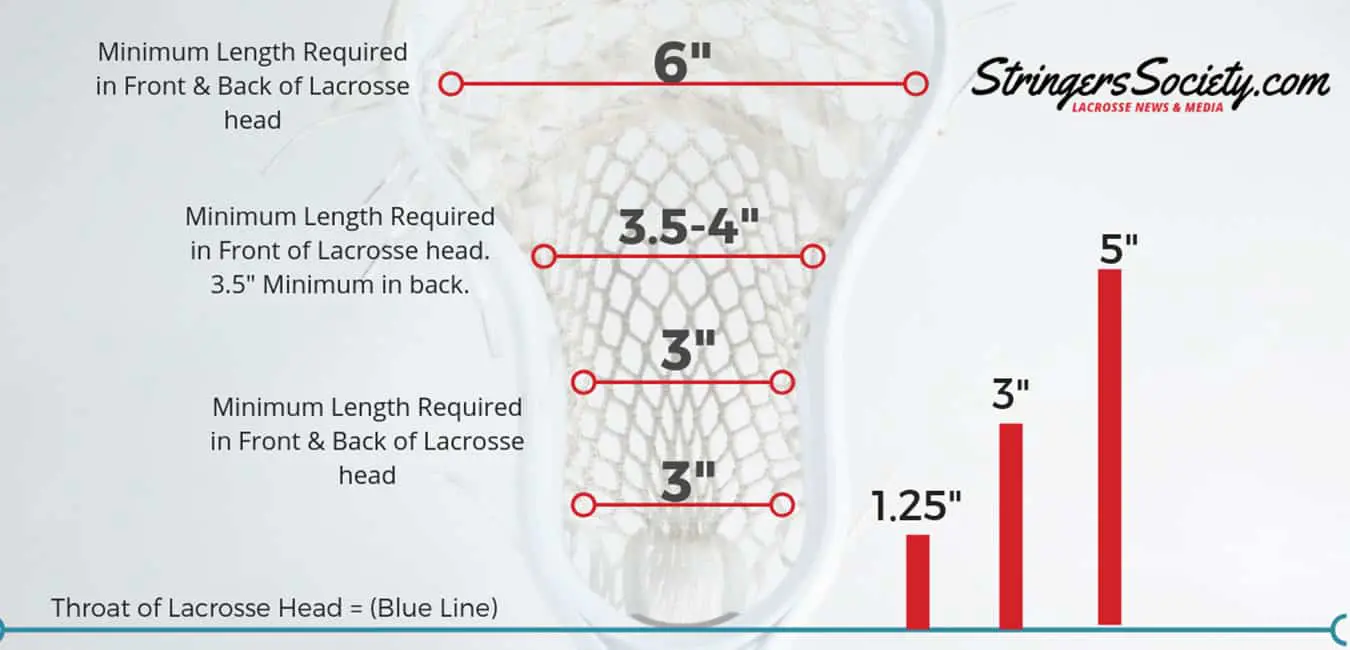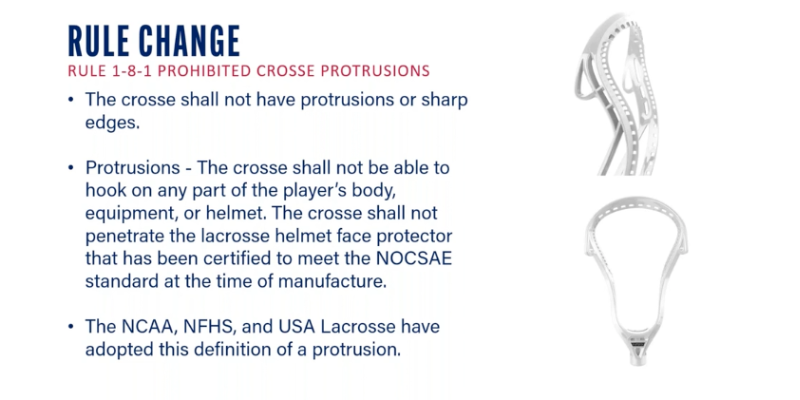We have updated lacrosse stringing rules for 2023 NCAA and NFHS men’s lacrosse. Learn the rules of lacrosse heads, shafts, and lacrosse stringing for stick checks.
NFHS & NCAA Lacrosse Stick Rules
The NFHS (National Federation of State High School Associations) and NCAA (National Collegiate Athletic Association) have set rules for lacrosse sticks to ensure player safety and fair competition. These rules outline specifications for the length, weight, and pocket depth of the stick, as well as the materials used in its construction. The rules also dictate the permissible dimensions and specifications of the stringing or mesh used to create the pocket in the head of the stick. The NFHS and NCAA work together to regularly update these rules to accommodate the game’s evolution and maintain a level playing field for all players.

NFHS Lacrosse Rules: Crosse Stick Regulations
2023 Stringing Updates
The updated lacrosse stringing rules for 2023 include a new clause in Rule 1-7-1, which specifies the maximum size of holes or gaps in a player’s crosse pocket/net. The holes or gaps must not be larger than 1.68 inches in diameter, which is roughly equivalent to the size of an American golf ball.

This new language was added to prevent players from using a stringing technique that creates larger holes or gaps in the mesh, allowing them to trap the ball more easily. The updated rule aims to promote fairness and consistency in the lacrosse game.
2023 Head Updates
The latest lacrosse head rule update includes a modification to Rule 1-8, which governs the design and construction of lacrosse crosses. The updated rule states that crosses “shall not have protrusions or sharp edges” in order to prevent injury to players.

This change was made in response to recent stick design innovations that included features that could hook or catch on a player’s helmet or other equipment, posing a potential risk of injury. The new rule aims to promote player safety and ensure that all players can participate in the game without the risk of injury from their equipment. The updated rule emphasizes the importance of fair play and responsible equipment design in the sport of lacrosse.
Previous Lacrosse Stick Rules still in effect
In addition to the updated lacrosse rules for 2023, the previous rules remain in effect and continue to apply. This means that all players must still abide by the previous regulations and guidelines set forth by the governing body overseeing the competition. It is important to be aware of both the updated and previous rules in order to ensure compliance and maintain fair play in the sport of lacrosse. Regular updates and modifications to the rules aim to improve player safety, accommodate changes in the game, and maintain a level playing field for all participants.
- Refs, hold your stick perpendicular to the ground and slowly turn it 90 degrees forward to see if the ball falls out. Refs repeat the same test in the opposite direction, but horizontally. If the ball doesn’t fall out, your lacrosse pocket is illegal. Illegal pockets need updated lacrosse stringing.
- Your lacrosse pocket shouldn’t be deeper than one lacrosse ball. Any gap between your lacrosse head and the ball makes the pocket illegal. This is called the “daylight test” because you can’t see daylight above the ball if the pocket is legal.
- Pull strings are also illegal and cannot be used in your lacrosse pocket; although, you can get away with them if you want to risk it. If a ref finds a pull string for fixing an illegal lacrosse pocket, you could be given an unsportsmanlike conduct penalty.
- Lacrosse tape touching any part of the lacrosse head is illegal. For faceoffs, you must have tape, or some cover, of a different color than your shaft and gloves on the top six inches of your shaft below the head. This will be checked on those players before the game and at the X.
- Shaft angle is measured with the “table test.” Lay your stick facedown on the table with the butt end slightly hanging off. If the highest point of the head is more than 2 3/4 inches off the table, then your stick is illegal. Refs will also look for relative straightness in other directions.
- There are also measurement tests to see if your lacrosse head and shaft are legal. Refs check several measurements listed below in the lacrosse head and shaft rules.
Shooting String Rules for NFHS & NCAA
- Hanging strings must not exceed the length of two inches from the tie off. So just cut your strings after stringing your lacrosse stick and don’t be lazy. This rarely gets called; but, it’s gonna be really embarrassing and annoying if you get called out for it by the ref.
- Shooting strings can’t be lower than four inches from the top of your lacrosse head. For good measure, never go more than five diamonds down in most meshes. You can also just stick to two shooters in the top of your head and never have to even think about this being an issue.
NCAA Lacrosse Stick Regulations
- Lacrosse heads must be a minimum of three inches wide at the throat; and at the widest point, between six and ten inches from inside of the crosse head. Learn more about the parts of a lacrosse stick.
- The length of a lacrosse head is required to be a minimum of 10 inches from the outside top of the crosse head to the beginning of the throat of the lacrosse head. This measurement does not include your ball stop and will be measured from the plastic by referees.
- The mid-point of the lacrosse head must be a minimum of 3.5 inches. The midpoint is defined as being 5 inches from the start of the plastic on the head.
- The ball stop of a crosse head is not needed unless you will be using a wooden lacrosse head. Ball stops can’t be thicker than 1/4 inch.
- The lacrosse head can be made from synthetic material, wood, or laminated wood. The sidewall of the crosse head shall not exceed more than two inches wide.
- You cannot saw your lacrosse head near the throat of the lacrosse head to get your hand closer to the ball for faceoffs.
NCAA Lacrosse Pocket Rules & Regulations
- Lacrosse pockets can include, gut, rawhide, linden, or synthetic material and should be a triangular shape. This is a rather outdated rule that is describing traditional lacrosse sticks, but it’s somewhat applicable. Lacrosse heads are already a triangle, and your pocket should match that.
- Lacrosse pockets that sag too deep are illegal. There is the test of space between the ball, but some lacrosse pockets evade that test. If a ref believes your stick is withholding the ball too much they will test it again with the forward and backward test mentioned above.
- Multiple-color lacrosse mesh is allowed, although it can be deemed illegal if it seems as if the player is trying to deceive the opponent. An example would be painting a white circle on the
black mesh, so it looks like you have the ball.
NFHS Lacrosse Stick Rules
- In high school, players lacrosse heads must be a minimum of 3 inches wide at the throat.
- The widest point of the lacrosse head near the scoop must be a minimum 6 inches wide and 3.5-4 inches at the midpoint. The midpoint is defined as 5 inches from the inside of the throat.
- From the top of the scoop to the throat of the lacrosse head must be at least 10 inches in length.
Clarification for past & future rules:
Warrior Lacrosse recently came out with a new lacrosse head called the Warp. This head has the pocket fixed to the lacrosse head and is not replaceable. The NCAA Lacrosse Association released an official statement saying that it is legal for play and referees should check the same way as a normal stick.
Frequently Asked Questions
To determine if a lacrosse stick is illegal, referees perform three tests to check the stick’s hold, which is how the ball stays in the head of the stick. The tests include a forward tilt, lateral tilt, and perpendicular tilt. If the ball remains in the stick after the stick has undergone these movements, it is considered illegal and cannot be used in the game. It is essential to check your stick before each game to make sure it complies with the rules set by the governing body overseeing the competition. This ensures that the game is played fairly and that all players have equal equipment.
Referees perform stick checks to ensure that all players are using legal equipment during a lacrosse game. The purpose of the stick check is to verify that the stick’s dimensions, weight, and pocket depth comply with the rules set by the governing body overseeing the competition. A stick check is also performed to make sure that the stick’s stringing or mesh does not create an advantage for the player, such as an excessively deep pocket or larger holes that can trap the ball easily. If a player’s stick is found to be illegal during a stick check, any points scored with that stick will not count and the player must switch to a legal stick before continuing the game. Stick checks are an important aspect of fair play and player safety in lacrosse.
The Gait D Head is not legal for play in lacrosse according to current rules set by governing bodies such as the NFHS (National Federation of State High School Associations) and the NCAA (National Collegiate Athletic Association). This is because the Gait D Head has protrusions on the sides of the top of the head that are designed to ensnare an opponent’s stick, which is not permitted in the game.
String like the pros!
Master stringing with our tutorials and get pro-grade supplies at Stringer’s Lacrosse Shop.
